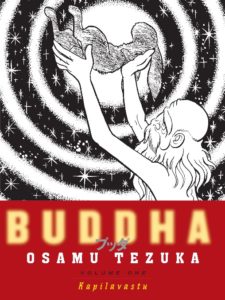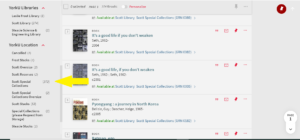In this blog post, CTASC practicum student Brian Omran discusses Japanese graphic novelist Osamu Tezuka and his multi-volume work, Buddha.
Osamu Tezuka (1928-1989) is renowned as one of the greatest graphic novel artists in the world. He earned the moniker “the Godfather of Manga”, referring to the Japanese style of cartoons and comics that he created. Famous for making breakthroughs with the medium in the 1950s, he helped manga gain tremendous popularity not only within Japan, but internationally as well. He created many award-winning graphic novels including Astro Boy, Kimba the White Lion, and Buddha. The Clara Thomas Archives and Special Collections has the complete eight-volume set of Buddha, which tells the story of Gautama Buddha in illustrated form. The series was originally published between 1972 and 1983. American publishing company Vertical, specialists in bringing Japanese-language graphic novels to the North American market, issued these English-language translated volumes in both hardback and paperback between 2002 and 2007.

Buddha is quite different from other examples of manga, as it bears closer resemblance to Western and almost Disney-esque cartoons with its images compared to how the Japanese version of the medium transformed over the decades. Many of the drawings are smooth and curvy, which creates a stronger sense of whimsy when reading the story. While modern manga still often makes use of smooth images, there’s also a mix of more angular and sharp images to create more striking impressions. In this way, Buddha effectively shows Osamu’s unique early style of manga illustrating.
Another notable element about the illustrations is their lack of colour. To those more familiar with Western graphic novels, this may seem like an odd choice. Most manga is printed entirely in black and white, even in the modern day, as a cost-saving measure so that more people can access the medium easily. This also means that the style of illustrations in Buddha focuses entirely on creative uses of black and white shades to create impressive visuals.
While the lack of colour may prove initially puzzling to those unfamiliar with manga, those who are at least casual readers of the medium will themselves be confused by Buddha’s reading order. These English translations of Buddha are unique because publisher Vertical printed the volumes so that the story is read left to right, meaning all the images are mirrored. In the traditional Japanese style, manga is written and illustrated in such a way that the original is meant to be read right to left. Most modern English translations of manga adhere to this convention.
Buddha is a unique series of graphic novels that highlight both early elements of manga that are less commonplace today, as well as certain elements that have persisted as staples of the medium. It is just one example from the Clara Thomas Archives and Special Collections' Graphic Novel Collection.
To search for other graphic novels in this collection, use York University Libraries catalog’s advanced search option.

Then perform a call number search for “GRN”.

Then filter your results by selecting YorkU location “Scott Special Collections”. This will bring up a list of the books in this collection, which can then be searched further by keyword, author and title.

Other Osamu Tezuka resources:
Vox article about Osamu Tezuka biography
The experimental short films of Osamu Tezuka [includes video]
Tezuka and the dawn of TV animation [Osamu Tezuka Manga Museum]
Inside the Osamu Tezuka Manga Museum in Osaka, Japan
Revival of the god of manga [Osamu Tezuka Manga Museum]

